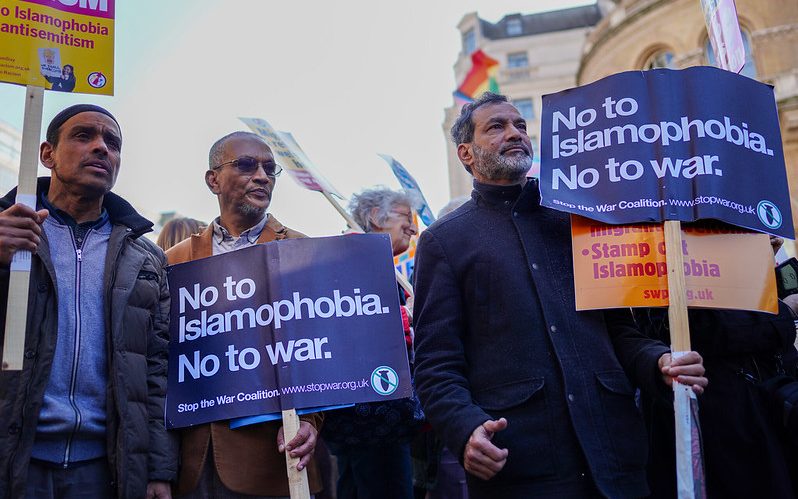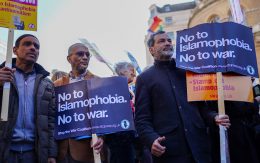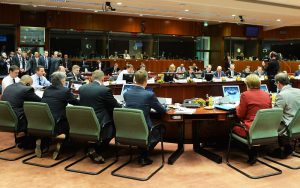In recent years, the internet has emerged as a dynamic platform accommodating diverse groups characterized by high levels of polarization. This digital landscape not only amplifies the voices of the prevailing majority but also assumes a pivotal role in the construction of individual identities and the formation of opinions. Consequently, the internet has become an environment conducive to the dissemination of hate group ideologies, effectively serving as a breeding ground for their propagation. While the proliferation of hate groups online may appear unremarkable or inconsequential, it is important to recognize that the absence of regulation within this sphere inadvertently lends a semblance of legitimacy to such groups. Tragically, this validation often manifests in real-life violence perpetrated against individuals.
One specific demographic that is frequently the target of online hate groups is the Muslim community. Muslims are increasingly subject to various forms of attacks, vilification, and hatred, propagated through extremist groups operating in the digital sphere1.
In Western contexts, far-right and nationalist European movements, including but not limited to the English Defence League (EDL), Britain First, and Pegida2, strategically utilize online platforms as their primary channels for disseminating ideological messages and recruiting new adherents3. Notably, the occurrence of anti-Muslim rhetoric has experienced a notable surge following significant incidents such as the September 11, 2001, terrorist attacks in New York City and the 7/7 bombings in London4. These events have served as catalysts for a substantial increase in negative sentiments directed towards the Muslim community.
Understood from the lens of national security, Muslims residing in Western societies have increasingly assumed the role of the contemporary “folk devils” within the collective imagination of popular media5. In this model, Islam is frequently positioned as a political ideology, and cultural framework inherently predisposed to violence, extremism, and devoid of diversity or acceptance6. Within this context, Muslim men are often depicted as crude, violent, and extremist archetypes epitomizing terrorism and ignorance, while Muslim women are portrayed as symbolic embodiments of gender oppression within Islam, with particular emphasis on their choice to wear the veil7. As a result, these persistent prejudices serve as a breeding ground for offline anti-Muslim hate crimes.
In line with the research conducted by Tell MAMA, a British association8, individuals subjected to Islamophobic sentiments frequently encounter harassment both within the online and offline domains9. Notably, instances of online Islamophobia can be identified across various social networking platforms, including Twitter, Facebook, and YouTube10. The utilization of online communication channels serves as a means to mobilize members for offline protests and demonstrations, a practice that carries inherent risks of exacerbating fear, fostering anti-Muslim animosity, and, in certain instances, inciting tangible acts of violence offline.
The phenomenon of online Islamophobia has emerged as a significant concern, exerting tangible effects on offline actions. Nonetheless, the limited scholarly attention dedicated to comprehending the dynamics of Internet-based Islamophobic discourses has impeded a comprehensive understanding of the historical trajectory of the modern Muslim world, often erroneously portrayed as a homogenous entity. To address this gap, this article investigates the influence of online Islamophobic discourse on instances of offline anti-Muslim hate crimes within the United Kingdom. Furthermore, it contends that online Islamophobia yields diverse impacts in both the virtual and physical domains. Specifically, I argue that, while online hate speech is deeply rooted in Islamophobic sentiments and exhibits distinct characteristics from offline forms of abuse or violence, substantial evidence supports the assertion that online hate speech serves as a catalyst for offline actions. Moreover, I argue that amidst the proliferation of Islamophobic discourse in online spaces, the dissemination of fake news and misinformation thrives within echo chambers, perpetuating a cycle of prejudice and intolerance.
Defining Islamophobia
Islamophobia is a term formed by appending the suffix ‘phobia’ to the word ‘Islam,’ conveying the notion of fear or apprehension towards the Islamic faith. Conceptually, it suggests that Islam is perceived as an ‘other,’ an entity deemed potentially hazardous to Western society. The phrase has gained significant prominence in association with the so-called ‘war on terror,’ as acts of terrorism, notably commencing with the events of 9/11, have significantly shaped societal perceptions of Muslims11. By portraying Islam in a negative light, the media has played a role in reinforcing such perceptions. Throughout this article, the definition of Islamophobia established by the Runnymede Trust will be adopted. As per their characterization, Islamophobia encompasses not only unjustified animosity towards Islam but also the marginalization of Muslims from mainstream political and social domains, as well as the tangible ramifications of such hostility on individuals and communities adhering to the Islamic faith12.
Online Hate Speech as a Catalyst for Offline Action
The United Kingdom has witnessed a significant growth in its Muslim population, yet the complex interplay of socio-political factors often gives rise to repercussions affecting ordinary individuals. An illustrative example of this occurred with the murder of Drummer Lee Rigby in Woolwich during May 2013, which sparked a surge of anti-Muslim animosity on social media platforms, subsequently manifesting itself in the streets of Britain. Moreover, the actions of Islamic State terrorists, such as the killing of British relief worker David Haines in September 2014, contribute to the demonization of Muslims and Islam, effectively “legitimizing” acts of violence directed against Muslims in both online and offline contexts13.
The prominence of Muslim individuals being identified as victims assumes a crucial role within the realm of online Islamophobia, as it serves as a catalyst for inciting anti-Muslim violence across digital and physical domains. Muslims can become targets on social networking sites based on various distinguishing factors, including their names, attire depicted in profile pictures (such as traditional dresses for women or beards for men), and statements indicating their adherence to the Islamic faith. Furthermore, targeting may also occur based on the videos or posts an individual likes or follows. According to Awan’s research, a notable number of individuals who experienced online anti-Muslim hate crimes were easily identifiable as Muslim women14. Zempi adds that women wearing niqabs15, in particular, frequently experience targeted offline anti-Muslim hate crimes. These incidents frequently entail the endurance of ongoing online abuse, including derogatory name-calling, threats of physical harm, cyberstalking, and sexual harassment, along with facing anti-Muslim hostility in public environments.
Awan conducted an extensive analysis of derogatory phrases employed to denigrate Muslims, revealing a range of offensive terms in use. Examples included “Muslim pigs” (9%), “Muzrats” (14%), “Muslim Paedos” (30%), “Muslim terrorists” (22%), “Muslim scum” (15%), and “Pisslam” (10%)16. Additionally, Tell MAMA conducted a study examining the portrayal of Muslims on social networking sites throughout the period spanning from January 2013 to December 2013. The researchers compiled a list of frequently used terms with clear connections to prejudiced attitudes and anti-Muslim discrimination. Notably, the terms “Ninja,” “Muzrats,” and “Paedo” emerged as prominent disparaging labels directed towards Muslims17. In a separate investigation, Awan developed a typology of eight individuals identified as cyber trolls, characterizing them as individuals who exploit social networking platforms, particularly Twitter, to incessantly propagate hate against Muslims. The analysis of 500 tweets encompassed a detailed examination of the language employed to portray Muslims in a negative light18.
Empirical investigations have yielded compelling findings indicating that a significant section of reported Muslim hate crimes are transpiring in the online realm. Notably, approximately 69% of these documented incidents, amounting to nearly 300 cases, can be attributed to far-right political entities such as the English Defence League (EDL) and British National Party (BNP)19. Furthermore, in-depth analyses have revealed a notable gender disparity, with the perpetration of online hate predominantly traced back to male individuals. It is worth noting that in certain instances, the online threats materialize into concrete offline actions, underscoring the tangible consequences arising from the virtual sphere.
The presence of online hateful activities within the United Kingdom is evident. Extensive scholarly research has been conducted to investigate the phenomenon of online Islamophobia20. However, a significant realization has emerged, shedding light on the perception of Islam as a monolithic entity by individuals propagating hatred against it. The notion of Islam as a monolith implies not only a perceived inability of Islam to adapt to contemporary contexts, such as the United Kingdom, but also a fundamental incompatibility between Islam and Western civilization. This perspective is exemplified in a particular tweet, which states:
“Death penalty for apostasy, adultery, homosexuality … is not radical … it’s Islam! #Brexit” (25 June, 2016)21
The aforementioned tweet aims to depict Islam as a monolithic entity characterized by extremism, thereby advocating for its eradication from Western society. Such a claim, which posits the intrinsic violence of Islam, stems from a limited comprehension of the multifaceted nature of Islam as a comprehensive belief system encompassing diverse practices, historical contexts, and factions. Another tweet, reinforces a similar sentiment, asserting that Islam is fundamentally incompatible with Western civilization, while applauding the occurrence of Brexit. It states:
“Secular democracy is not a suicide pact. Islam is simply incompatible with Western civilization. Bravo for #Brexit” (25 June 2016)22
The tweet highlights how Brexit is utilized as a means to perpetuate online anti-Muslim hatred. It is crucial to acknowledge that while these expressions of anti-Muslim sentiment may have political undertones, they ultimately serve to achieve broader political objectives at a collective level. In this regard, the portrayal of Islam aligns with the dichotomous construct of the “West and The Rest,” reinforcing Western superiority while marginalizing other cultural and religious identities. Consequently, the general alienation of Islam can be perceived as a recurring political trope rooted in these dynamics.
Dissemination of Fake News and Misinformation
In addition to the offline manifestation of online hate crimes, the issue of online Islamophobia encompasses a significant concern related to the rise and proliferation of fake news. Prominent digital platforms such as Twitter and Facebook serve as global networks, attracting like-minded individuals and providing spaces for social interaction. Unfortunately, it is within these spaces that the phenomenon of fake news and misinformation emerges.
The functioning of social networking sites as facilitators of free information exchange and interpersonal communication creates an environment that can inadvertently nurture extremist discourses. Consequently, these platforms have become breeding grounds for the dissemination and cultivation of misinformation, a particularly alarming trend in recent times. It is crucial to distinguish between misinformation and disinformation. Disinformation generally refers to the unintentional sharing of false news, whereas misinformation pertains to the purposeful creation and dissemination of fabricated and manipulated information, explicitly intended to deceive and propagate harmful rhetoric23.
In a recent scholarly article published in the Journal of Ethnic and Racial Studies, significant insights regarding the relationship between misinformation and Islamophobia were brought to the forefront24. The study revealed that instances of online hate, particularly targeting Muslims, often stem from a triggering event, such as the COVID-19 pandemic. Throughout the protracted duration of the pandemic, individuals were able to maintain a greater degree of anonymity, leading to a notable surge in online Islamophobic and xenophobic sentiments25.
As previously discussed, these triggering events are intrinsic to highly charged virtual spaces that are specifically oriented towards generating anti-Muslim discourse. For instance, the association between Brexit-related hashtags and inflammatory Tweets exemplifies how Brexit served as a prominent triggering event in fostering online Islamophobia. Consequently, online Islamophobic narratives become entwined with a distinct political trigger event, resulting in a proliferation of hate speech within mainstream online discourse.
To illustrate, a pertinent case study can be observed in India, where a prominent media outlet, known as ‘The Hindu,’ depicted the COVID-19 virus as inherently linked to Muslims and portrayed Tablighi Jamat members as super spreaders. This particular incident serves as a noteworthy illustration of online Islamophobia intertwined with misinformation, directly associated with a triggering event26.
Analyzing the role of trigger events is crucial for comprehending the dynamics between online and offline manifestations of Islamophobic discourse. The scholarly contributions of Williams and Burnap provide valuable insights into the detection of cyber hate following the occurrence of trigger events. Their research illuminates the phenomenon of online hate having a diminishing impact over time, as exemplified by the Woolwich attack. This implies that after a specific trigger event, there is a discernible period during which posts targeting Muslims or expressing any form of cyber hate gradually decrease in frequency27. Consequently, this demonstrates that virtual platforms such as Twitter or Facebook are influenced by multiple factors that contribute to the emergence of specific discourses. While some of these discourses may indeed be Islamophobic, it is essential to acknowledge the intricate interplay of various factors that underpin the surfacing of such rhetoric.
Thus, the study emphasizes the significance of understanding the complex interplay between trigger events, online Islamophobia, and the dissemination of misinformation, shedding light on the multifaceted nature of this phenomenon.
Submit here
Conclusion
The impact of online Islamophobic discourse on offline anti-Muslim hate crimes is a critical issue that requires attention from scholars, policymakers, and society at large. This paper has examined the influence of online Islamophobia on instances of offline violence within the United Kingdom, highlighting the significant consequences of hate speech in both virtual and physical domains.
The findings suggest that online hate speech serves as a catalyst for offline action, with incidents of anti-Muslim violence often originating from online platforms and subsequently manifesting in real-life attacks. Muslim individuals, particularly women wearing niqabs, are disproportionately targeted, facing persistent online abuse and enduring offline hate crimes. The prevalence of derogatory language and offensive terms directed towards Muslims on social media further exacerbates the problem. Moreover, the role of trigger events in fostering online Islamophobia and the dissemination of fake news and misinformation needs to be emphasised: The COVID-19 pandemic and Brexit serve as examples of triggering events that have fuelled anti-Muslim sentiments online, leading to the proliferation of hate speech within mainstream discourse.
However, it is crucial to recognize that Islamophobic discourse online is not a monolithic entity, and the multifaceted nature of Islam and its diverse adherents should be acknowledged. Additionally, the interplay of various factors, such as political objectives and cultural dynamics, contributes to the perpetuation of anti-Muslim rhetoric online.
While this article has shed light on the impact of online Islamophobic discourse, it is important to acknowledge its limitations. Further research is needed to explore the experiences of other marginalized groups, the role of social media algorithms in amplifying hate speech, and effective strategies for countering online Islamophobia and its offline consequences.
In conclusion, addressing the impact of online Islamophobic discourse on offline anti-Muslim hate crimes requires a multi-faceted approach that involves education, regulation, and the promotion of inclusive and tolerant societies. By understanding the complexities of this issue and continuing to investigate and counter online hate speech, we can work towards a more inclusive and harmonious future.
Sources Allen, Chris. ‘Britain First: The ‘Frontline Resistance ‘to the Islamification of Britain’. The Political Quarterly 85, no. 3 (2014): 354–61. Awan, Imran. ‘Islamophobia and Twitter: A Typology of Online Hate against Muslims on Social Media’. Policy & Internet 6, no. 2 (2014): 133–50. Awan, Imran, Pelham Carter, Hollie Sutch, and Harkereet Lally. ‘Online Extremism and Islamophobic Language and Sentiment When Discussing the COVID-19 Pandemic and Misinformation on Twitter’. Ethnic and Racial Studies 46, no. 7 (2023): 1407–36. Awan, Imran, and Irene Zempi. ‘We Fear for Our Lives: Online and Offline Experiences of Anti-Muslim Hate Crime’. Birmingham City University, Nottingham Trent University, TellMAMA, 2015. https://irep.ntu.ac.uk/id/eprint/25975/1/221908_3389.pdf. Bakali, Naved. Islamophobia: Understanding Anti-Muslim Racism through the Lived Experiences of Muslim Youth. Vol. 5. Springer, 2016. Bakry, Muammar, Abdul Syatar, Islamul Haq, Chaerul Mundzir, Muhammad Arif, and Muhammad Majdy Amiruddin. ‘Arguing Islamophobia during COVID-19 Outbreaks: A Consideration Using Khuṣūṣ Al-Balwᾱ’. International Journal of Criminology and Sociology 9, no. 6 (2020): 2757–65. Barker, Renae. ‘Banning the Burqa Is Not the Answer to Fears about Public Safety.’ Newspaper. The Conversation, 22 September 2014. https://theconversation.com/banning-the-burqa-is-not-the-answer-to-fears-about-public-safety-31628. Copsey, Nigel, Janet Dack, Mark Littler, and Matthew Feldman. ‘Anti-Muslim Hate Crime and the Far Right’, 2013. http://tellmamauk.org/wpcontent/uploads/2013/07/antimuslim2.pdf. Digital, Culture, Media and Sport Committee. ‘Disinformation and “Fake News”: Final Report’, 2019. https://publications.parliament.uk/pa/ cm201719/cmselect/cmcumeds/1791/1791.pdf. Dodd, V, and M Williams. ‘British Muslims Fear Backlash after David Haines Murder’. Newspaper. The Guardian, 2014. www.theguardian. com/world/2014/sep/14/britain-muslimsbacklash-fear-david-haines-murder. Evolvi, Giulia. ‘Hate in a Tweet: Exploring Internet-Based Islamophobic Discourses’. Religions 9, no. 10 (2018): 307. Feldman, Matthew, and Mark Littler. ‘Tell MAMA Reporting 2014/2015: Annual Monitoring, Cumulative Extremism, and Policy Implications’, 2015. Poynting, Scott, and Victoria Mason. ‘The Resistible Rise of Islamophobia: Anti-Muslim Racism in the UK and Australia before 11 September 2001’. Journal of Sociology 43, no. 1 (2007): 61–86. Poynting, Scott, and Greg Noble. Living with Racism: The Experience and Reporting by Arab and Muslim Australians of Discrimination, Abuse and Violence since 11 September 2001: Report to the Human Rights and Equal Opportunity Commission. Centre for Cultural Research, University of Western Sydney Sydney, 2004. Poynting, Scott, and Barbara Perry. ‘Climates of Hate: Media and State Inspired Victimisation of Muslims in Canada and Australia since 9/11’. Current Issues in Criminal Justice 19, no. 2 (2007): 151–71. Runnymede Trust. ‘Islamophobia: A Challenge for Us All’. Runnymede Trust Publications and Resources, 1997. https://www.runnymedetrust.org/companies/17/74/Islamophobia-A-Challenge-for- Us-All.html. Williams, Matthew L, and Pete Burnap. ‘Cyberhate on Social Media in the Aftermath of Woolwich: A Case Study in Computational Criminology and Big Data’. British Journal of Criminology 56, no. 2 (2016): 211–38. Zempi, Irene, and Neil Chakraborti. Islamophobia, Victimisation and the Veil. Springer, 2014.
Footnotes
- Scott Poynting and Victoria Mason, ‘The Resistible Rise of Islamophobia: Anti-Muslim Racism in the UK and Australia before 11 September 2001’, Journal of Sociology 43, no. 1 (2007): 61–86; Scott Poynting and Barbara Perry, ‘Climates of Hate: Media and State Inspired Victimisation of Muslims in Canada and Australia since 9/11’, Current Issues in Criminal Justice 19, no. 2 (2007): 151–71. [>]
- Patriotic Europeans against the Islamisation of the West [>]
- Chris Allen, ‘Britain First: The ‘Frontline Resistance‘ to the Islamification of Britain’, The Political Quarterly 85, no. 3 (2014): 354–61. [>]
- Scott Poynting and Greg Noble, Living with Racism: The Experience and Reporting by Arab and Muslim Australians of Discrimination, Abuse and Violence since 11 September 2001: Report to the Human Rights and Equal Opportunity Commission (Centre for Cultural Research, University of Western Sydney, 2004). [>]
- Irene Zempi and Neil Chakraborti, Islamophobia, Victimisation and the Veil (Springer, 2014), 25. [>]
- Renae Barker, ‘Banning the Burqa Is Not the Answer to Fears about Public Safety.’, Newspaper, The Conversation, 22 September 2014, https://theconversation.com/banning-the-burqa-is-not-the-answer-to-fears-about-public-safety-31628. [>]
- Imran Awan, ‘Islamophobia and Twitter: A Typology of Online Hate against Muslims on Social Media’, Policy & Internet 6, no. 2 (2014): 133–50. [>]
- Tell Measuring Anti-Muslim Attacks (MAMA) A British association who intends to counter anti-Muslim crimes. [>]
- Giulia Evolvi, ‘Hate in a Tweet: Exploring Internet-Based Islamophobic Discourses’, Religions 9, no. 10 (2018): 307. [>]
- Imran Awan and Irene Zempi, ‘We Fear for Our Lives: Online and Offline Experiences of Anti-Muslim Hate Crime’ (Birmingham City University, Nottingham Trent University, Tell MAMA, 2015), https://irep.ntu.ac.uk/id/eprint/25975/1/221908_3389.pdf. [>]
- Naved Bakali, Islamophobia: Understanding Anti-Muslim Racism through the Lived Experiences of Muslim Youth, vol. 5 (Springer, 2016). [>]
- ‘Islamophobia: A Challenge for Us All’, Runnymede Trust Publications and Resources, Runnymede Trust, 1997, 4, https://www.runnymedetrust.org/companies/17/74/Islamophobia-A-Challenge-for- Us-All.html. [>]
- V Dodd and M Williams, ‘British Muslims Fear Backlash after David Haines Murder’, Newspaper, The Guardian, 2014, www.theguardian. com/world/2014/sep/14/britain-muslimsbacklash-fear-david-haines-murder. [>]
- Awan, ‘Islamophobia and Twitter: A Typology of Online Hate against Muslims on Social Media’. [>]
- Some Muslim women choose to wear a garment that conceals their faces called a niqb or niqaab. This garment, which is often black and known as a ruband, is considered to be an interpretation of the hijab. [>]
- Awan, ‘Islamophobia and Twitter: A Typology of Online Hate against Muslims on Social Media’, 141. [>]
- Matthew Feldman and Mark Littler, ‘Tell MAMA Reporting 2014/2015: Annual Monitoring, Cumulative Extremism, and Policy Implications’, 2015. [>]
- Awan, ‘Islamophobia and Twitter: A Typology of Online Hate against Muslims on Social Media’, 144. [>]
- Nigel Copsey et al., ‘Anti-Muslim Hate Crime and the Far Right’, 2013, 21, http://tellmamauk.org/wpcontent/uploads/2013/07/antimuslim2.pdf. [>]
- Copsey et al., ‘Anti-Muslim Hate Crime and the Far Right’; Zempi and Chakraborti, Islamophobia, Victimisation and the Veil; Awan, ‘Islamophobia and Twitter: A Typology of Online Hate against Muslims on Social Media’; Awan and Zempi, ‘We Fear for Our Lives’. [>]
- Evolvi, ‘Hate in a Tweet: Exploring Internet-Based Islamophobic Discourses’, 7. [>]
- Ibid. [>]
- Digital, Culture, Media and Sport Committee, ‘Disinformation and “Fake News”: Final Report’, 2019, https://publications.parliament.uk/pa/cm201719/cmselect/cmcumeds/1791/1791.pdf [>]
- Imran Awan et al., ‘Online Extremism and Islamophobic Language and Sentiment When Discussing the COVID-19 Pandemic and Misinformation on Twitter’, Ethnic and Racial Studies 46, no. 7 (2023): 1407–36. [>]
- Awan et al., 1427. [>]
- Muammar Bakry et al., ‘Arguing Islamophobia during COVID-19 Outbreaks: A Consideration Using Khuṣūṣ Al-Balwᾱ’, International Journal of Criminology and Sociology 9, no. 6 (2020): 2757–65. [>]
- Matthew L Williams and Pete Burnap, ‘Cyberhate on Social Media in the Aftermath of Woolwich: A Case Study in Computational Criminology and Big Data’, British Journal of Criminology 56, no. 2 (2016): 211–38. [>]








In today’s highly digitalized society, a significant proportion of the world population considers the internet or social media as their primary source of information, making it more important than ever to discuss the intricacies and downsides of social networking sites and how they play a significant role in the marginalization of certain communities.
A very well-written attempt by the author. Kudos!